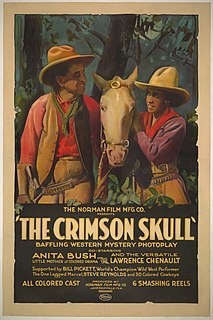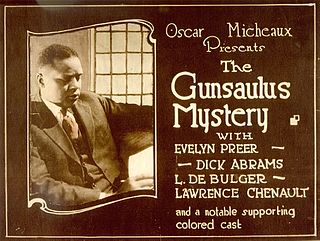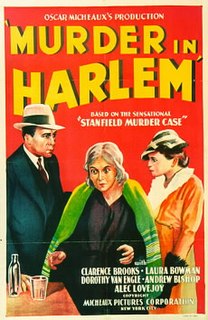
Charles Waddell Chesnutt was an African-American author, essayist, political activist and lawyer, best known for his novels and short stories exploring complex issues of racial and social identity in the post-Civil War South. Two of his books were adapted as silent films in 1926 and 1927 by the African-American director and producer Oscar Micheaux. Following the Civil Rights Movement during the 20th century, interest in the works of Chesnutt was revived. Several of his books were published in new editions, and he received formal recognition. A commemorative stamp was printed in 2008.

Oscar Devereaux Micheaux was an author, film director and independent producer of more than 44 films. Although the short-lived Lincoln Motion Picture Company was the first movie company owned and controlled by black filmmakers, Micheaux is regarded as the first major African-American feature filmmaker, a prominent producer of race films, and has been described as "the most successful African-American filmmaker of the first half of the 20th century". He produced both silent films and sound films.

Evelyn Preer, was a pioneering African-American stage and screen actress and jazz and blues singer of the 1910s through the early 1930s. Preer was known within the black community as "The First Lady of the Screen."
The tragic mulatto is a stereotypical fictional character that appeared in American literature during the 19th and 20th centuries, starting in 1837. The "tragic mulatto" is a stereotypical mixed-race person, who is assumed to be depressed, or even suicidal, because they fail to completely fit in the "white world" or the "black world". As such, the "tragic mulatto" is depicted as the victim of the society that is divided by race, where there is no place for one who is neither completely "black" nor "white".
Gertrude Sanborn was an American journalist, short story writer, and novelist.

Alice Burton Russell was an African-American actress, producer, and the wife of director Oscar Micheaux. She appeared in several films directed by her husband.

Lawrence Chenault was an American vaudeville performer and silent film actor. He appeared in approximately 24 films between years 1920 and 1934; most of his performances were in films directed by pioneering African-American filmmaker Oscar Micheaux. His brother, Jack Chenault, was also a film actor.

Lorenzo Tucker, known as the "Black Valentino," was an American stage and screen actor who played the romantic lead in the early black films of Oscar Micheaux.

The Gunsaulus Mystery is a 1921 American silent race film directed, produced, and written by Oscar Micheaux. The film was inspired by events and figures in the 1913-1915 trial of Leo Frank for the murder of Mary Phagan. The film is now believed to be lost. Micheaux remade the film 1935 as Murder in Harlem.

Murder in Harlem is a 1935 American race film written, produced and directed by Oscar Micheaux, who also appears in the film. He remade his 1921 silent film The Gunsaulus Mystery.

A Daughter of the Congo is a 1930 race film directed, written and produced by Oscar Micheaux. The film is loosely based on the novel The American Cavalryman (1917), by African-American novelist and playwright Henry Francis Downing. It is considered a lost film.
The Conjure Woman is a 1926 silent film directed, written, produced and distributed by Oscar Micheaux. A race film featuring an African-American cast and catering to an African-American audience, it stars Evelyn Preer and Lawrence Chenault, with support from character actors Peter Verwayen, Alma Sewell and Sidney Easton. It is based on American writer Charles W. Chesnutt's 1899 short story collection of the same name. No print of the film has been located and it is presumed to be a lost film.
The House Behind the Cedars is a 1927 silent race film directed, written, produced and distributed by the noted director Oscar Micheaux. It was loosely adapted from the 1900 novel of the same name by African-American writer Charles W. Chesnutt, who explored issues of race, class and identity in the post-Civil War South. No print of the film is known to exist, and it is considered lost. Micheaux remade the film in 1932 under the title Veiled Aristocrats.

The House Behind the Cedars is the first published novel by American author Charles W. Chesnutt. It was published in 1900 by Houghton, Mifflin and Company. The story occurs in the southern American states of North and South Carolina a few years following the American Civil War. Rena Walden, a young woman of mixed white and black ancestry, leaves home to join her brother, who has migrated to a new city, where he lives as a white man. Following her brother's lead, Rena begins living as a white woman. The secret of her identity leads to conflict when she falls in love with a white aristocrat who learns the truth of her heredity. The ensuing drama emphasizes themes of interracial relations and depicted the intricacies of racial identity in the American south.
The Symbol of the Unconquered is a 1920 silent "race film" drama produced, written and directed by Oscar Micheaux. It is Micheaux's fourth feature-length film and along with Within Our Gates is among his early surviving works. The Symbol of the Unconquered was made at Fort Lee, New Jersey, and released by Micheaux on November 29, 1920. A print of the film is extant at the Museum of Modern Art in New York. The film is based on the way perceptions of race shape human relationships.
Easy Street is a 1930 American film by Oscar Micheaux, an African American filmmaker. It features an African American cast. Known as the last silent achievement in his filmography, the film is considered lost. The plot reportedly revolved around a group of con artists trying to seize the savings of an old man.
The Spider's Web is a 1926 Oscar Micheaux film starring Evelyn Preer. It was remade in 1932 as The Girl from Chicago.
The Broken Violin is an American silent film directed by Oscar Micheaux, released in 1928.
Carl Mahon was an actor in the United States. An African American, he had several film roles including a starring role in the 1932 film The Girl from Chicago
Willor Lee Guilford was an African American actress. She had substantial parts in several films including at least three Oscar Micheaux films.










